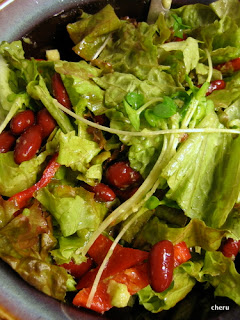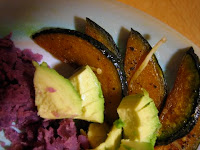There are certain foods I give up on while I'm in Japan. I don't really eat cheese. I don't really drink wine. There are more than enough other delicacies to distract myself with anyway.
日本に滞在する時に西欧のようなチーズとワインより日本のおいしい納豆、焼酎。
Happily, Japan has plenty of locally produced animal-based creaminess just in case my cholesterol levels plummet. Aside from its world-renowned marbled beef, Japan boasts high-quality dairy, much of it from the northernmost island of Hokkaido. When William Smith Clark of Massachusetts helped found an agricultural college in what was then, in the 1870s, Japan's wild wild north, his advice was: "Boys, be ambitious!" Judging from the reputation Hokkaido has cultivated as a creamy wonderland, the boys did just that.
幸いに日本でもとてもおいしい日本産牛乳を手に入れるので、せめてそれでコレステロールもたっぷり食べれます。1870年代に北海道の農産大学を作るために来日したウィリアム・スミス・クラークの有名な言葉は「少年よ、大志を抱け!」その北の搾乳場は確かによくできたね。
I thought it might be kind of funny to set up a kind of "Got milk?" photograph to illustrate these musings:
子どものころからずーっと見えた牛乳キャンペーンをまねして、ミルクの口ひげの写真を撮ろうと思いながら。。。
The results were pretty lewd. Leading me to wonder what exactly the "Got milk?" campaign was really selling me. As I pondered how truly disturbing the image of a disembodied mouths can be, and as I debated whether I should post these photos, I also wondered...
気味悪いね。いったいなぜそのキャンペーンに人気があったの?
...if I should invoke the term "vagina dentata." Too late. I already did. Hi, Mom!
ただ口を映ると気味悪い。失礼しました。食べ物に戻ろうね。
Back to the matter at hand, Japanese milk is sweet and creamy. It reminds me of some cold glasses I've had in the American Midwest.
手短かに言えば、日本のミルクに魅力があります。甘くてクリーミー。アメリカの農業地域も思い出す。
For mayonnaise, too, I am spoiled here. Kewpie turns out a nice one. The secret ingredient? Maybe monosodium glutamate, which was isolated and patented by Ajinomoto, a Japanese corporation, in the early 20th century. MSG also goes by the name
ajinomoto--the root of flavor--in colloquial speech. If youtube would cooperate with me, this would be the sentence in which I would offer a link to a clip from the television show in which I witnessed Japanese schoolgirls squirting Kewpie mayonnaise into their mouths. Thwarted, I will now turn to a more tasteful presentation of Kewpie mayo.
日本にいる間にマヨネーズの心配もないね。我の友にキューピーがあるから。キューピーの秘密は何でしょう?味の素?アメリカに広く嫌われた味の素かな?ま、口に合うから私は文句を言いません。
Don't gaze too long into the vortex of mayonnaise. There's more to come!
驚嘆の念でいっぱいですか?
Tonight I basically enlisted the help of the creamy ingredients celebrated above to transform the food already in my fridge into a feast.
今晩は日本産牛乳、マヨネーズの手伝いで冷蔵庫にあったものをごちそうに変革しました。
I had pasta dough left from my chestnut noodles (see Autumn #9). I thought ravioli might be a nice variation. For that, I'd need to make ricotta. I slowly brought some whole milk mixed with cream and a pinch of salt to a rolling boil.
秋#9のポストからパスタの生地が残って、それをラヴィオリーにしよう!まずはリコッタチーズを作る。そのため、牛乳とクリームと少々の塩をゆっくり沸かした。
When it was going hot and heay, I added some lemon juice, and reduced the mix to a simmer as it curdled. The mix went through a cheesecloth (that's what they are for!), and waited patiently for an hour as it dripped dry.
よく沸いていた時にレーモン汁を少し入れて、凝乳になるまで2分間ぐらい混ぜた。このミルクをガーゼで液体を抜けた。
"Real" ricotta may actually be made with rennet, but until I can get my grubby hands on them, the lemon juice done good.
本当にチーズを作るならレネットという材料が必要かもしれない。でもレネットがどこで買えるか分からない私にもレーモン汁で結構だ。
Okay, maybe this spoonful went directly into my mouth. But I was able to reserve some for the pasta dough, which I rolled out and cut into circles with the help of a rice bowl.
実言えば、この写真を撮ったとたん、このスプーンは直接に私の口に入れたしまった。できるだけ我慢して、チーズをパスタに使わなきゃーと思って、パスタ生地を薄くして、茶碗を使って、まるい形にした。
To this, a little ricotta, with a little impression in the middle.
これに、リコッタ:
In this little valley, an egg yolk.
リコッタの真ん中の谷に、卵の黄身:
Another round of pasta dough.
もう一枚のパスタ生地:
Boil it until it goes belly up. I found four minutes to be the best.
それで4分ほど茹でる。
Please note how the pasta clings to the fillings, revealing yet concealing the gooey goodness within.
外面から挑発的に中身が見えるね。
Topped with a little browned butter...
バーターを載せて。。。
And some ginger-garlic-bacon ratatouille on the side.
しょうがとニンニクとベーコンのラタトゥイユと。
I haven't forgotten that mayo. It found its way into some mashed kabocha, which I had simmered with soy sauce and mirin. I added some yuzu kosho (citrus ground with pepper) for an extra kick.
マヨネーズを忘れずに、煮たカボチャとゆずこしょうにすりつぶした。
This, alongside a sesame coleslaw of sorts...
これと薄切りにされたキャベツサラダ。。。
And avocado (because I can't resist) made for a nice side dish.
とアボカドでおかず。
With all these flavors at my command, I was able to build such beautiful bites as this:
これでこの贅沢な一口が作られた:
Sure, I play with my food...
そうね。子供のように食べ物で遊びするね。。。
And I lick my plate clean...
その上、動物のようにお皿までなめる。。。
But at this point, I can't see any reason to resist these impulses. I'm busy eating.
でも大人さえ知らない満足。



























































